Recuperation: Efficient braking energy recovery
- Details
- Hits: 4703
The active has three essential components Energy Management System Pxt from Michael Koch for recuperation from braking energy: Electronic devices, storage units and a small, intelligent module. The electronic devices push the energy highly dynamically and reliably either from Power Type into the memory or vice versa as in the case of a voltage interruption. The small module for current-based Load peak reduction and capacity monitoring complete the energy handling for drives.

Contents
- Recuperation not only in electric cars
- New braking energy manager
- Four applications that are fun
- FAQ
Recuperation not only in electric cars
The recuperation when braking is certainly superficially known when it comes to the conversion of kinetic energy into electrical energy E-cars goes. The e-car recovers energy while driving through energy recovery when braking. The kinetic energy of electric vehicles is used to generate electrical energy and in the Battery save. This allows the range of an electric car to be extended and at the same time wear on the brake system is reduced.
But recuperation does not only play a role in the field of electromobility. Also in the industrial Drive Technology it is increasingly being used to work more efficiently and in a way that conserves resources. Michael Koch GmbH is a supplier of such energy management systems for recuperation when braking electric drives in industry. Here we present the new and further developments.
New braking energy manager
Find out what's new from Upstadt-Weiher in terms of "saving braking energy, bridging power interruptions" below:
Energy recovery with UL approval and capacity monitoring
 08.05.2023 | The active energy management devices from Michael Koch's Pxt family are now approved according to the UL and CSA standards. In addition, the technology is now able to monitor the storage capacity during operation. The parameterizable function of the running capacity monitoring of electrolytic and double-layer capacitors brings warning messages when a previously defined minimum capacitance value is reached.
08.05.2023 | The active energy management devices from Michael Koch's Pxt family are now approved according to the UL and CSA standards. In addition, the technology is now able to monitor the storage capacity during operation. The parameterizable function of the running capacity monitoring of electrolytic and double-layer capacitors brings warning messages when a previously defined minimum capacitance value is reached.
There are three ways of perception for the user: Via an LED display on the device, a defined digital output or a defined message via Communications interface like the fieldbus. This ensures that the usable energy quantity of the Pxt devices is always sufficient for the respective application over the operating period or that maintenance is carried out at an early stage in the sense of predictive maintenance.
More performance, a more stable network, more machine safety with a longer service life and lower energy consumption of the electrical drive technology are the features of the active Pxt energy management devices for Energy recovery.
Now also with approval according to North American standards UL and CSA The recuperators in combination with the drive and machine simplify international use, even beyond North America.
Plug-on module for ampere-precise mains load peak reduction
27.02.2023/XNUMX/XNUMX | To ensure that the energy required for peak loads on a machine comes from a device for recuperation and not from the power grid, the following must be done: The Module Pxt MX on an electronic device Pxt family Plug in, supplied sensors for measuring the current for the three phases and enter the maximum value for the mains current, which is exact in terms of amperes. With the energy management systems from Michael Koch, you can optimally design the energy handling for your drives.
With the small, intelligent Pxt MX box, Michael Koch's Pxt energy management family is now can be integrated into fieldbuses. It can be used to reduce peak loads and limit the input current of the drive - all via plug-and-play.
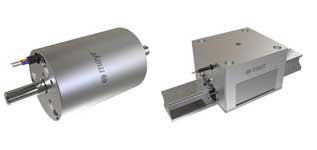 Tips for installing a safety brake
Tips for installing a safety brake
Bis over 100 A the measuring and thus control range of the Pxt MX is sufficient. With its help and the connected Pxt system, many applications with a lower effective current can be brought below the rated current limits of the mains fuses, for example 63 A or 32 A.
Regardless of the expansion size of the Pxt system, peak load reduction with the Pxt MX remains just as easy. The use is visualized in real time using the Pxt Terminal tool. In addition, all Pxt devices for energy recovery of a brake can be parameterized and monitored.
New device family for active braking energy management
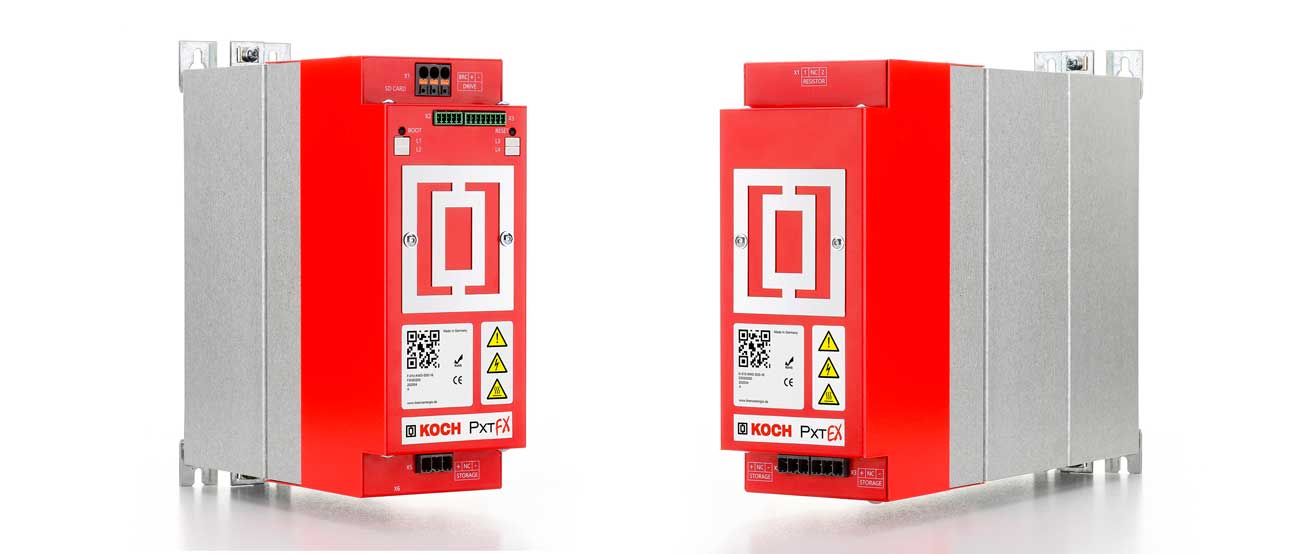
17.03.2020/XNUMX/XNUMX | Ten years of market experience and many years of development work have gone into the devices from Michael Koch GmbH for braking energy recuperation. The devices for Brake Energy Regeneration Pxt FX, Pxt EX and Pxt RX open up new possibilities for the active management of the energy of electric drives. They have a wide voltage range and offer a wide range of possible applications, regardless of the manufacturer.
The applications of the modular family of devices for recovering electrical energy when braking are based on using excess or necessary electrical kinetic energy to a large extent to be cached independently of the network. The selection of storage media also depends on the application. Special aluminum electrolytic capacitors are used for short and very frequent cycles. Double-layer capacitor modules are suitable for higher kinetic energy and less frequent cycles. The battery is used for rare cycles.
The connecting part between drive and storage is the active energy management device. The Product family Pxt (also pronounced "P times t" = equal to energy) is now reaching a new dimension with significantly higher functionality than the previous systems for energy recovery that have been available on the market since 2010.
Braking energy recuperation for frequent, short cycles
 The two active devices for recuperation Pxt FX and Pxt RX are complemented by the Pxt EX, a modular storage unit with one or more aluminum electrolytic capacitors. The applications are diverse and bring the device benefits through a singular feature or through the combination of two or more properties. By means of recuperation of the machine, the increase energy efficiency. In its smallest expansion stage, the Pxt FX can save up to 1 kWh of energy in 1,2 s cycles / h.
The two active devices for recuperation Pxt FX and Pxt RX are complemented by the Pxt EX, a modular storage unit with one or more aluminum electrolytic capacitors. The applications are diverse and bring the device benefits through a singular feature or through the combination of two or more properties. By means of recuperation of the machine, the increase energy efficiency. In its smallest expansion stage, the Pxt FX can save up to 1 kWh of energy in 1,2 s cycles / h.
In relation to the application, the active brakes can be used to implement energy management systems based on the Pxt FX Generate savings of up to 40%. However, other uses often play a greater role than increasing energy efficiency.
An example is the compensation of the brownouts mentioned, the safe and defined standstill in the event of blackouts, the possible acceleration of production processes with an increase in output of up to 50%, the reduction of network load peaks or the electric drive in operation independent of the power grid.
With a current load capacity of 20 A continuous and 40 A peak for around 1 min compared to storage with a maximum voltage of 450 V DC, the Pxt FX can generate up to 18 kW of power. The energy recovery device can be factory fitted with a Storage volume of 2 or 4 kWs be equipped.
The automatic detection of the brake transistor switch-on voltage threshold is installed as standard. This allows the device to be used with all commercially available frequency converters and servo controllers to work together in plug-and-play design. The extensive safety features of the Pxt FX protect against reverse polarity of the intermediate circuit connections, connection of charged brakes, energy storage and overloading of the system on the storage and intermediate circuit side.
Internal fuses are standard. The SD memory card, an external 24 V power supply, status displays via LEDs, bootloading and reset options and 6 digital I/Os are also available. A USB module supplements the output functionalities.
Braking energy recovery with extended storage volume
The device for braking energy recuperation Pxt EX is used when the memory volume of the Pxt FX is not sufficient. A Pxt EX can store 2, 4 or 6 kWs of energy with its aluminum electrolytic capacitors specially developed for use with active energy management systems. Simply via cable with reverse polarity protection Plugs connected to the Pxt FX, the memory expansion comes directly into play.
 Kettcar for adults has a range of 200 km
Kettcar for adults has a range of 200 km
Internally secured, the individual storage units visually indicate their charging status via a flashing LED. The Pxt EX comes standard with a safe discharge resistor integrated. This helps bring the entire system to a voltage level that is harmless to humans. Basically, the devices for the recuperation of Brakes energy low maintenance.
Energy recovery for higher loads
 While the device Pxt FX was designed for use of repetition cycles from ms to a few s and was equipped with a service life of well over 100 million, its bigger brother Pxt RX designed for connection to storage devices with higher energy densities such as double-layer capacitors or batteries. The Pxt RX is designed for a current carrying capacity of 30 A continuous and 60 A peak for around 1 min. In conjunction with a high storage voltage of up to 800 V DC, the device can generate almost 50 kW.
While the device Pxt FX was designed for use of repetition cycles from ms to a few s and was equipped with a service life of well over 100 million, its bigger brother Pxt RX designed for connection to storage devices with higher energy densities such as double-layer capacitors or batteries. The Pxt RX is designed for a current carrying capacity of 30 A continuous and 60 A peak for around 1 min. In conjunction with a high storage voltage of up to 800 V DC, the device can generate almost 50 kW.
If the application requires more power, you can different Pxt RX and also Pxt FX devices connected in parallel become. This is how active systems for braking energy recuperation can be created, the big Control Cabinets to fill. Under the type designation KTS, Michael Koch offers ready-to-connect complete systems for Control Cabinets.
This includes active energy management systems from the Pxt family, application-specific brakes, energy storage, suitable fuses, cabling and passive or active discharge devices, which are selected depending on the memory used. Because the Pxt RX also works without problems with cable lengths to the intermediate circuit of up to 20 m, it is particularly suitable for such KTS switch cabinet Solutions.
Digital nameplate makes work easier
All devices have a digital nameplate. about one QR-Code The technical data can be scanned on the device using an app for Android, iOS smartphones or tablets, and inspection and test reports and the associated documents such as the assembly and operating instructions can be displayed. Users can access their individual documents and information from anywhere and without paper. Built-in management options allow machine builders to assign the devices with their respective properties to a machine or plant.
The Delivery Times the Pxt family are very short by the way. It is delivered fully parameterized ex works and ready for operation immediately after connection to the DC intermediate circuit. The devices can be updated to the latest firmware version via the SD memory card.
Four applications that are fun
We will introduce you to four interesting applications in which Michael Koch's active energy management systems are successfully used. What they all have in common is that the devices save money Total Cost of Ownership (TCO).
Assembly robots in the automotive industry
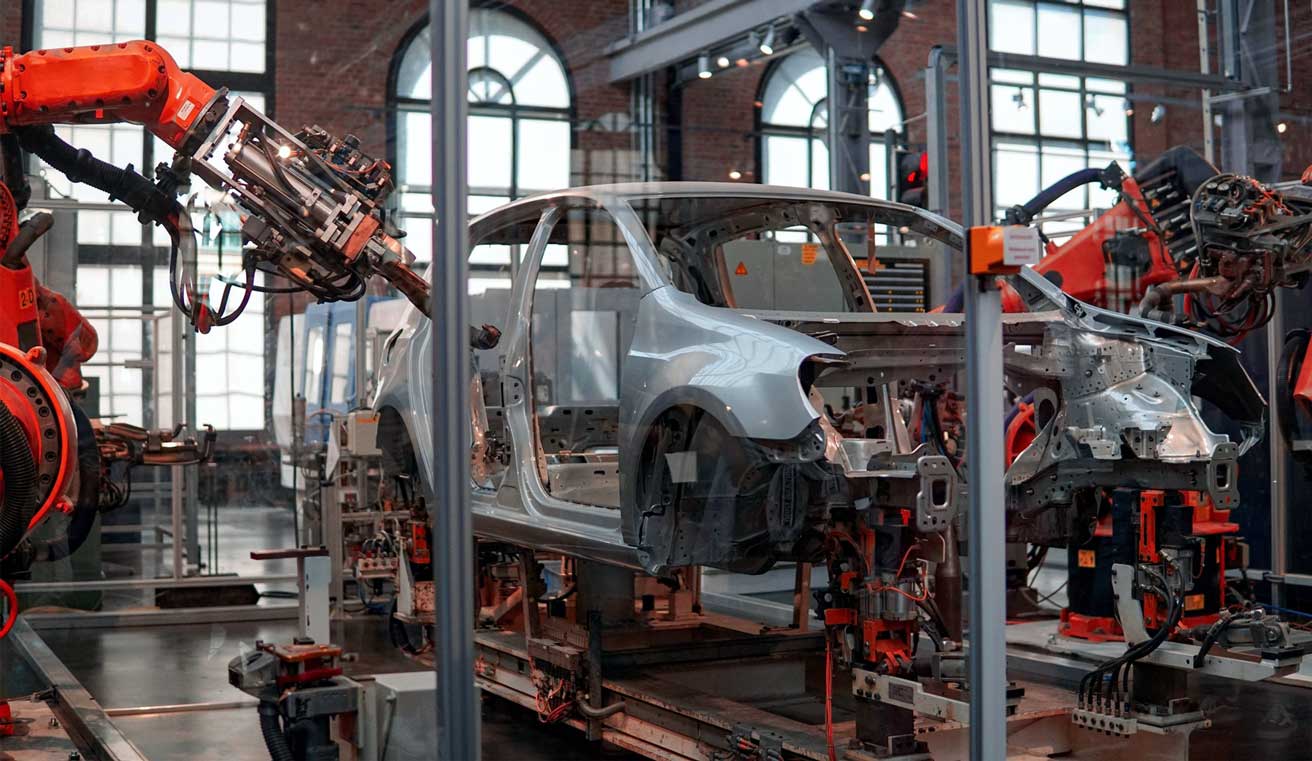
An automobile manufacturer wanted to make its vehicle production more energy efficient and therefore more environmentally friendly - not least because the current assembly process did not reduce CO22-Specifications met. In the new direction the should CO2-Footprint be as low as possible.
Michael Koch recommended an active solution as a solution Energy manager PxtFX to be used per robot. The device stores the robot's braking energy and returns it directly to it the next time it starts moving. The energy required is reduced by up to 1,6 kWh per device and operating hour due to recuperation.
The Robot can now be driven faster with lower energy consumption by using the PxtFX energy manager. The emerging braking energy is temporarily stored. If necessary, it is returned to the system.
Each device can produce up to 3,5 t of CO per year2 save on. This makes vehicle production much more climate-friendly.
More dynamics in the handling robot
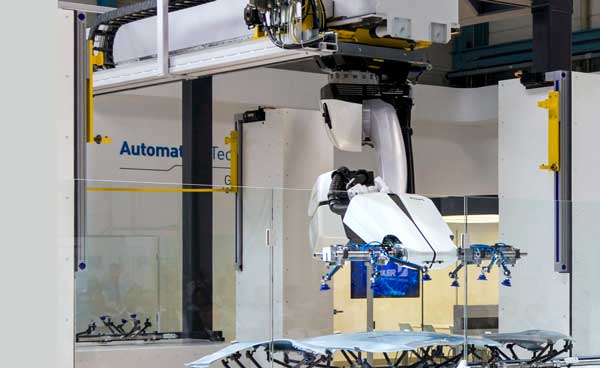 A manufacturer of handling robots wanted to increase the dynamics of its robot higher clock speeds achieve with reduced energy intake. The robot travels 12 cycles/min over a travel distance of 6,5 m. The power consumption is 10,7 kW. However, fast cycles and large masses overwhelm the drive electronics. Unplanned robot failures may occur.
A manufacturer of handling robots wanted to increase the dynamics of its robot higher clock speeds achieve with reduced energy intake. The robot travels 12 cycles/min over a travel distance of 6,5 m. The power consumption is 10,7 kW. However, fast cycles and large masses overwhelm the drive electronics. Unplanned robot failures may occur.
In order to increase the dynamics of the robot in the form of higher clock speeds and at the same time less energy To consume more energy, the brake energy managers recommended the plug-and-play solution PxtFX. The device stabilizes the intermediate circuit by storing braking energy and feeding it back in when necessary. Two PxtFX were installed in parallel for the linear travel axis and one PxtFX for the robot axis.
This conversion led to an increase Number of cycles from 12 to 15/min. This equates to a 25% increase in productivity. The power consumption is also reduced to 8 kW - also 25% in energy savings. The resulting braking energy is stored and returned to the system when necessary. All of these measures ultimately extend the service life of the drive electronics.
Plastic filling of fully electric injection molding machines
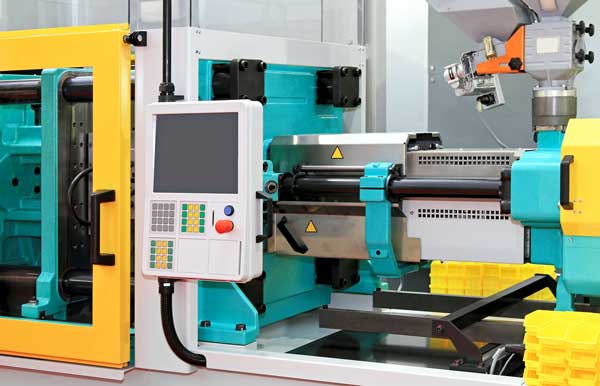 At a manufacturer of injection molding machines, this happened Filling the injection mold with liquid plastic to cause loss of mains voltage. However, if the net fails during the filling process of the molds, the tool and the workpiece can stick together. The result is high downtime and setup costs because the mold is difficult to open and can also be damaged.
At a manufacturer of injection molding machines, this happened Filling the injection mold with liquid plastic to cause loss of mains voltage. However, if the net fails during the filling process of the molds, the tool and the workpiece can stick together. The result is high downtime and setup costs because the mold is difficult to open and can also be damaged.
After consulting with the experts from Koch, we saw the solution immediate opening the shape in the event of a power failure. This would no longer cause the tool and the piece to stick together. This is the only way to avoid long downtimes, high operating costs and possible tool damage.
The contributed to solving the problem Plug and play solution PxtFX at. Via the energy manager and together with the emergency power supplier NEV, the drives receive sufficient energy without any delay in the event of a power failure to guarantee that the mold can be opened.
The Open tools now immediately in the event of a power failure. Voltage drops are compensated for. Short-term power failures are bridged without having to stop the system. No more injection molds or workpieces are destroyed.
Plant stoppage in the textile machinery industry
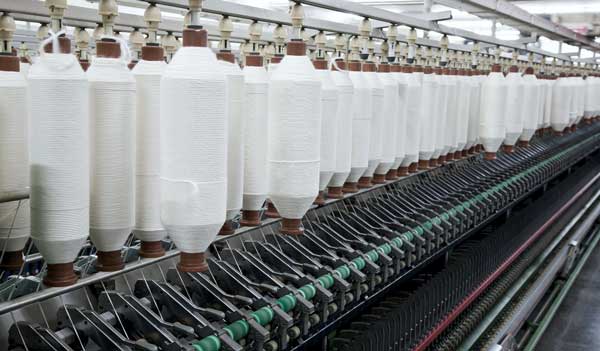 A textile machine manufacturer had the task of avoiding long downtimes as well as high set-up and downtime costs and protecting its system and materials. At Power failure and the speed then began to slow down below 10%, causing the machine to stop uncontrollably. The result was yarn breaks and tangles.
A textile machine manufacturer had the task of avoiding long downtimes as well as high set-up and downtime costs and protecting its system and materials. At Power failure and the speed then began to slow down below 10%, causing the machine to stop uncontrollably. The result was yarn breaks and tangles.
The restart could take hours, with high downtime costs. This was a big problem, especially in countries with unstable supply networks, where the power sometimes goes out several times a day.
In order to get this problem under control, several drives had to be coupled via an intermediate circuit. With the PxtFX energy manager and the Emergency power energy provider NEV, Michael Koch was able to implement a controlled system stop even in the event of a power failure.
In the event of a power failure, the drives are supplied with the energy necessary for the controlled stop without any time delay. Voltage drops are compensated for. Short-term network interruptions are bridged. Yarn breaks and yarn balls are a thing of the past. When the machine restarts, there is one enormous time savings and by protecting the material, there is also material savings.
FAQ
What is recuperation?
Recuperation refers to the process of Energy recovery, typically in electric drive systems such as electric vehicles or electric motors. The kinetic energy, which is normally lost as heat during the braking process, is converted into electrical energy and fed back into the battery.
How does recuperation work in a car?
Recuperation is a process in E-cars or Hybrid vehicles how plug is used in hybrids, mild hybrids, micro hybrids or other electric mobility vehicles when driving to recover electrical energy. The concept of recuperation is not new and has been used in electric cars for several years. When the electric vehicle brakes or the driver takes their foot off the accelerator, the resulting kinetic energy is converted into electricity by the electric car and stored in the battery. The result is greater efficiency and a longer range for the electric car. Recuperation is therefore an important factor when it comes to the sustainability and cost-effectiveness of electric cars.
How does recuperation work in industrial electric drives?
In industrial drives recuperation proves to be extremely efficient. Here it enables energy recovery, with which kinetic energy released during braking is converted back into electrical energy. This regenerative braking can then be used for other purposes. Recuperation is therefore ideal for increasing the efficiency of drives and reducing energy consumption at the same time. At a time when more and more companies are focusing on sustainability, recuperation will therefore play an increasingly important role in industry.
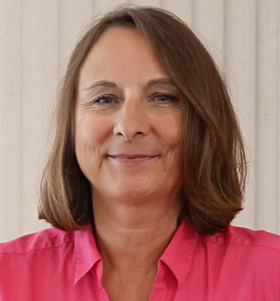
Angela Struck is editor-in-chief of the development scout and freelance journalist as well as managing director of Presse Service Büro GbR in Ried.
